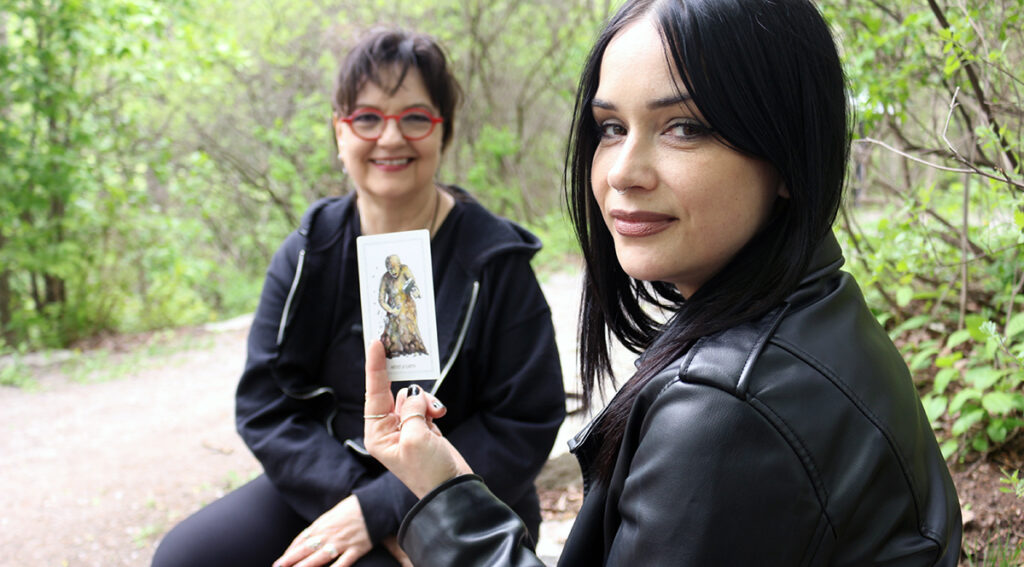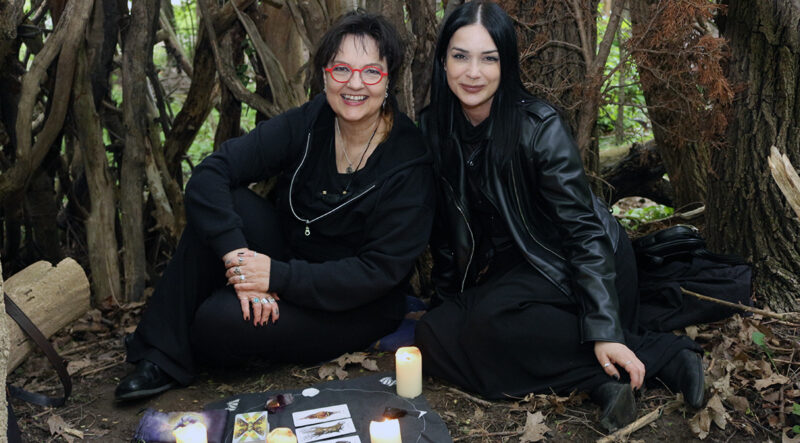Tarot card reader and artist Monica Bodirsky sits on a stone bench in Toronto’s Cedarvale Park, flipping a card and placing it upright on a cloth adorned with moon phases and bats. The rings on her fingers shimmer as sunlight filters through rainclouds and the park’s canopy. Across from her sits art director Laura Hokstad, her collaborator on the documentary Coven, listening intently as Bodirsky interprets the cards.
The deck is Bodirsky’s own design — The Awakening Tarot. The card she draws is the Artist of Earth, her version of the Queen of Pentacles in the Smith-Waite deck. She reads it like a story, offering comfort to Hokstad, who, like many creatives in a capitalist world, worries about her craft and income. Nine cards later, the reading ends, the candles are blown out and the two begin to banter. It’s a warm reunion of fellow witches — and far from a “cold reading,” where a tarot reader scans for cues like wedding bands or body language to make guesses.
“I think the ideal reader is someone who understands the symbolism, is well educated, has studied traditional meanings of the cards, but also uses their intuition in conjunction with their logic and knowledge,” Bodirsky said during a Zoom call in May. “You’re marrying both sides of what you know about, say, the Hanged Man card, intellectually — but it’s like a portal.”
Too many cards are misunderstood. Death. The Tower. The Fool. The Devil. They’re all more than stereotypes. Their meaning lies in how the reader interprets them. Still, bad actors and old myths fuel the stigma around tarot reading — fears of the occult, fraud and superstition still linger.
But understanding the symbolism and applying it with care can draw a clearer line between insight and exploitation. Before tackling the modern myths and misconceptions, it helps to look at where tarot came from — and how it evolved.
Constructing the archetypes
Tarot, or tarocci, started as a card game in 15th-century Italy, created for Duke Filippo Maria Visconti of Milan. A standard deck had 78 cards: 22 major arcana and 56 minor arcana, with suits of cups, pentacles, swords and wands. The major arcana begins with the Fool and ends with the World, charting a symbolic journey. The minor arcana runs from ace to ten, with court cards: king, queen, knight and page.
The goal of the game of tarocci was to win tricks, much like in bridge. The artwork reflected Christian imagery. It developed independently but alongside Germany’s Karnöffel, another trick-taking game focused on trump cards.
Tarot’s link to the occult didn’t appear until the 18th century, when French occultist Jean-Baptiste Alliette published a guide to tarot reading. His work laid the groundwork for the cards to be used as spiritual tools, not just entertainment.
Today, it has grown in popularity thanks to social media, including TikTok’s #TarotTok community. It grew more so during the pandemic, and tarot reader Liz Worth wrote a column in the Globe and Mail highlighting the craft’s importance in not just assuaging fears, but also helping to keep people grounded in the present.
It’s also grown within the LGBTQ+ and BIPOC communities, with the old religious symbols in the more traditional decks being pared away in favour of more inclusive imagery.
While tarot’s origins were Christian, its evolution into a natural, spiritual tool has shaped how many people see it today — for better or worse.

Laura Hokstad, right, shows the Artist card from The Awakening Tarot deck illustrated by Monica Bodirsky.
De-stigmatizing tarot
That spiritual association scared horror novelist Sephera Giron when she was younger. Even now, she admits she was hesitant to embrace tarot. It wasn’t until she became a single mom in her early 30s that she picked up her first deck.
“I always wanted to be that astrologer lady with the columns — and I’ve gotten to do that over the years,” she said. “But I was always terrified of the actual tarot cards.”
Living in Mississauga, she started visiting a crystal shop called The Source Within, which posted workshops on an old-school bulletin board. No websites — just tacked-up paper. One of those workshops was on tarot, and she signed up.
Soon, she was taking classes with a teacher named Vivah. “Every week, you’d learn two or three cards, and it was super in-depth. A deep dive,” she said. “(Vivah) was scary AF … she was super negative.”
Still, Giron learned a lot. Everyone got a reading at the end of each class. Many left in tears. From those classes, she formed a friendship with another student, Julie, and together they read tarot at Ad Astra under the cheeky name Two Stupid Witches.
Even so, she wasn’t a fan of being read herself, especially by author Nancy Kilpatrick or adult entertainer Annie Sprinkle.
“All I remember is I got the Devil and the Tower and some other shit,” she said. “It hit home. My husband had just left.”
Most of her fear, she admits now, was rooted in ignorance.
“You couldn’t really find information. The library didn’t have anything. You’d have to go to that secret book section.”
Now, thanks to mobile apps and online communities, tarot is more accessible.
“Everybody could do it. Everyone’s doing it. It’s like the stigma isn’t there as much,” she said. “You go to a party and everyone’s crowding the table.”
Debunking the myths
You don’t have to dig deep to find the movies that feature tarot, but admittedly, its representation is a hint of mystic and a dash of metaphor.
For Laura Hokstad, tarot is “special interest slash hyperfocus”. She’s a graphic designer and art director in the film industry, constructing props and details for film productions. And the first myth Hokstad bristles at, which is presented in the Nicholas Adams novel, Horrorscope, is the myth that a deck must be gifted.
“From my experience, and where I sit with it, there are still some pockets (where there’s) this kind of gatekeeping,” she said. “There used to be this theory that you couldn’t buy your tarot deck for the first time. You had to be gifted it.
“I think it’s a beautiful sentiment, and it speaks to how maybe underground it had to be and had to operate back in the day,” Hokstad added. “But now I feel like it’s more of a barrier, and it can be discouraging.”
The traditional Rider-Waite-Smith deck, with artwork done by Pamela “Pixie” Colman Smith, is the most common deck used. Bodirsky has designed her own decks, including her most recent release, The Awakening Tarot.
For her, the idea of gifting someone their first deck was a way of protecting one’s income.
“By keeping reading exclusive and protecting your livelihood, it becomes the ultimate gatekeeping for an esoteric practice,” she said. “You can’t just go out and buy a deck. How many people are going to gift you one?”
A myth that piggybacks onto the gifting one is that you cannot use another person’s deck.
“People will still hold onto that, along with other (myths) like you’re not supposed to charge for spiritual services,” she said. “If it’s a gift from the spirits, why are you making money from it?”
And if you use someone else’s deck? Some believe it becomes cursed. And the occult does play a major role in the stigmas or misinterpretation of tarot.
Black and white horror films would often play into the stereotype of a Romani person telling one’s fortunes. Maleva, played by Maria Ouspenskaya, was a Romani woman in The Wolf Man (1941), and her role was exotic and mysterious and in tune with the supernatural.
“These kinds of terrible stereotypes that have been lobbed at them, based on what the media has written, and how people see that art of divination,” Hokstad said. “In reality, the Romani divination traditions are definitely not rooted in tarot. There may be Romani people who use tarot, but that doesn’t mean that it’s a definition of their traditions.”
The Romani were a nomadic people from India who moved across Asia and into Europe during the 5th and 11th centuries. They settled mostly in parts of Bulgaria, Hungary, Romania, Serbia and Slovakia. Divination, cartomancy and fortune telling were not a spiritual practice, but rather a means of a survival trade, much like metalworking and basket weaving.
“There is a lot of friction in spiritual communities as soon as money comes into the picture,” Bodirsky said. “People seem to conflate that a great deal with fraud and con artists.
“It’s not unusual anymore to charge for esoteric, abstract or non-material services,” she added. “At one time it was. Chiropractors were once considered magic workers — a lot has changed.”
Hokstad agreed, adding that tarot being dangerous or satanic also plays into that theme of fraudulence.
“Cards like Death or the Devil are actually less about physical dying and the Devil himself, and more about … metaphor and nuance,” she said. “Seeing that death on a horse after a battle, what it’s actually talking about is the idea of rebirth. We have let the old patterns, beliefs and habits die so that we can give space for the new.”
Of course, beyond personal experience, public perception of tarot is often shaped by pop culture.
Pop culture’s influence
Pop culture hasn’t always helped. Elaine Parks leans into sentimentality as she recalls her Celtic cross reading to Officer Griff Meadows in the 2016 film, The Love Witch.
“For my future card, I got the Knight of Wands,” she reflects. “I always felt if that card showed up in a future reading, I’d soon meet the man that I’m going to marry.”
The Love Witch is the story of a young witch, Parks, who is trying to find the love of her life. But eventually she kills every man she falls for, including Jerry, her first, who is shown dead on the floor with the Three of Swords cards by his body. That card denotes heartbreak, emotional pain and sorrow.
It’s also a popular tattoo.
Other films like Dr. Terror’s House of Horrors, Nightmare Alley and the 2024 horror flick Tarot have leaned into tarot’s spooky side. But Bodirsky, who once consulted for Diahann Carroll on two Lifetime movies, said pop culture cuts both ways.
“They were concerned with how tarot was being portrayed, so I was hired,” she recalled. “Most films … work on a very low budget and sensationalism. I don’t think they carry a whole lot of weight.
“I think over time, those kinds of films disappear fairly quickly, and honestly, if anything, they might even promote tarot because people might be curious to see for themselves if they’re that spooky or dangerous.”
Tarot’s use in psychotherapy
As religious stigma fades, tarot is finding new life as a self-discovery tool. A study out of James Madison University showed how tarot can be effective in counselling. Researchers Renee Staton, Amanda Evans and Melinda Fox supported Eileen Clinton’s work exploring tarot as a projective tool.
Used in therapy, the cards act like a mirror. Clients project thoughts and feelings onto the images, often unlocking insights that talk therapy alone might not reach. Instead of predicting the future, the cards become a way to tell stories and reflect.
Bodirsky said psychologists are now using tarot in narrative therapy. And she’s even used it on paranormal investigations at haunted locations
“Because they’re archetypes, as long as you understand the key words, you can play with them symbolically,” she said of tarot’s use in narrative therapy.
Hokstad agreed, adding that academic research helps chip away at old stigmas.
“Using it as a tool for self-discovery is really valuable,” she said. “Just talking about it this way helps people move past those old beliefs.”
According to the team at James Madison, tarot may offer a low-cost, short-term therapy option for creative or introspective clients. And that’s no fool’s errand.

